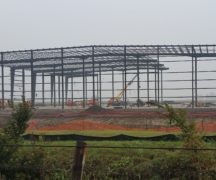By JAN McLAUGHLIN
BG Independent News
Bowling Green City Council can’t pass an income tax increase to pay for new fire stations and equipment – only city residents can do that.
So City Council member Greg Robinette wants to make sure citizens understand what’s at stake. At Monday’s council meeting, Robinette said he had asked Municipal Administrator Lori Tretter to give a detailed presentation at the July 7 council meeting about the complicated process that lies ahead.
On Monday evening, council heard the first reading of six ordinances and one resolution that must be passed to get the proposed 0.15% income tax increase on the November ballot, and redistribute 0.15% of the city’s current income tax to build two new fire stations and renovate the police station.
City Council is prohibited from increasing the income tax on its own.
“The only people who can pass the income tax in Bowling Green are the citizens of Bowling Green,” Robinette said.
But Robinette doesn’t want voters to get lost in the detailed process required for the city.
“It’s complicated. It takes a while to get your arms around it,” he said.
Also during Monday’s meeting council member Bill Herald said the fire and police facilities will be among the items discussed during the transportation and safety committee meeting on June 30, at 6 p.m. There will be time for citizens to ask questions and give input, Herald said.
Based on citizen comments on last week’s story about the proposed income tax levy, it appears the city has some disinformation to confront.
On social media, readers suggested that the new data center north of the city be taxed for the fire and police stations. However, the data center is not in Bowling Green. Others cited the recently passed school levy, and asked why the city needs more. Others questioned the city’s spending on the Slippery Elm Trail resurfacing and the turf put in at the high school – neither of which the city paid for. Another suggested the better option might be a federal grant – however, those are drying up at unprecedented rates. And yet another reader suggested perhaps fundraisers and raffles be held to raise money for the fire stations – estimated at $30 million.
After years of discussion on the condition of the Bowling Green Police Station, the Court Street Fire Station, and the desire to decrease emergency response times in the city, a proposal was presented to the Council Committee of the Whole last Thursday evening.
Municipal Administrator Lori Tretter and Finance Director Dana Pinkert presented a plan addressing the fire station needs first and putting the police station needs on a temporary pause.
Based on the increase in fire and EMS calls, and the unsafe conditions at the Court Street Fire Station, the following recommendations were made:
- Two new stations will be constructed, and the Pearl Street Station will remain in operation.
- A station with administrative headquarters will be built somewhere in the north end of the city, in the area between Haskins and Main streets, and Newton and Van Camp roads. Negotiations are still going on between the city and the landowner, Tretter said. That station will be larger, at an estimated 20,944 square feet.
- A satellite station will be built in the southeast area of the city, on property already owned by the city at Carter Park. Tretter stressed that all the recreation uses will remain in the park, with the disc golf course possibly needing to be reconfigured. This satellite station will be an estimated 14,215 square feet.
- The predicted cost of building and equipping the two new stations will be in the ballpark of $30 million. That includes $14.7 million for the headquarter station, $10.5 for the satellite station, $2.5 million for an aerial ladder truck, and $2 million for other fire and ambulance equipment.
The police station is also in dire need of improvements in its 130-year-old building downtown. Not only is the space difficult to use for a modern police operation, it’s also not user-friendly for the public.
City officials asked that the police station renovations be revisited, with no definite decisions being made now. It was suggested that the police renovations be paid for with the reallocated city capital improvement funds.
Pinkert explained a proposal to change the long-standing process of how the existing income tax is distributed among city departments. She suggested 0.15% of the existing 0.3% income tax collection go from the water/sewer capital fund into a capital improvement fund and street repair fund.
But that will only pay a portion of the costs for the new fire stations. So Pinkert also recommended that City Council place a 0.15% income tax increase on the November ballot.
Utilities Director Brian O’Connell explained that to make up for the capital improvement money taken from the water and sewer funds, those rates will need to be increased to collect about $1.5 million annually.
The average residential customer in Bowling Green would see their monthly water bill go up 70 cents, and their monthly sewer bill go up by $1.10, O’Connell said.
Even with the increases, Bowling Green residential bills will be lower than many in the region, he said. Currently, the total monthly water and sewer bill for a residential customer in Bowling Green is $36.95, compared to $54.13 in Findlay, $93.10 in Perrysburg, $107.08 in Defiance, $136.25 in Maumee, and $147.45 in Napoleon.
That will be up to the BG Board of Public Utilities to set any rate increases.
But it is up to City Council to put an income tax on the ballot. The filing deadline to get on the ballot is Aug. 6, and council is required to have three readings of such resolutions.
If the income tax passes, construction would begin in 2026, Tretter said.
As the city grows, the demands increase. But response times cannot, if the city wants to provide best chances of survival for people and property.
At Monday’s City Council meeting, Mayor Mike Aspacher announced that the Bowling Green Fire Division has again received the American Heart Association’s Mission: Lifeline EMS Gold Plus Achievement Award for implementing specific quality improvement measures to treat patients who suffer severe heart attacks. A big part of successfully treating heart attacks has to do with quick response times.
The number of fire and EMS calls have tripled, from 1,095 calls for service in 1992, to 3,418 calls in 2022. The number is expected to hit 4,000 this year.
Demands on the police division also continue to grow. Calls for service have doubled from approximately 15,000 in 1984, to 30,000 in 2024. In that same period, the number of officers has gone from 28 to 42, and the number of dispatchers has grown from nine to 11.
After Monday’s meeting, Aspacher said the income tax increase and the reallocation of the existing income tax revenues work together to form a “responsible plan” for the city to plan for growth.
While the new income tax would be used to build two new fire stations and purchase new fire equipment, the reallocation of the existing tax would pay for renovations to the police station and streetwork.
“We will not be coming back at a later date to fund the police renovations,” Aspacher said.





